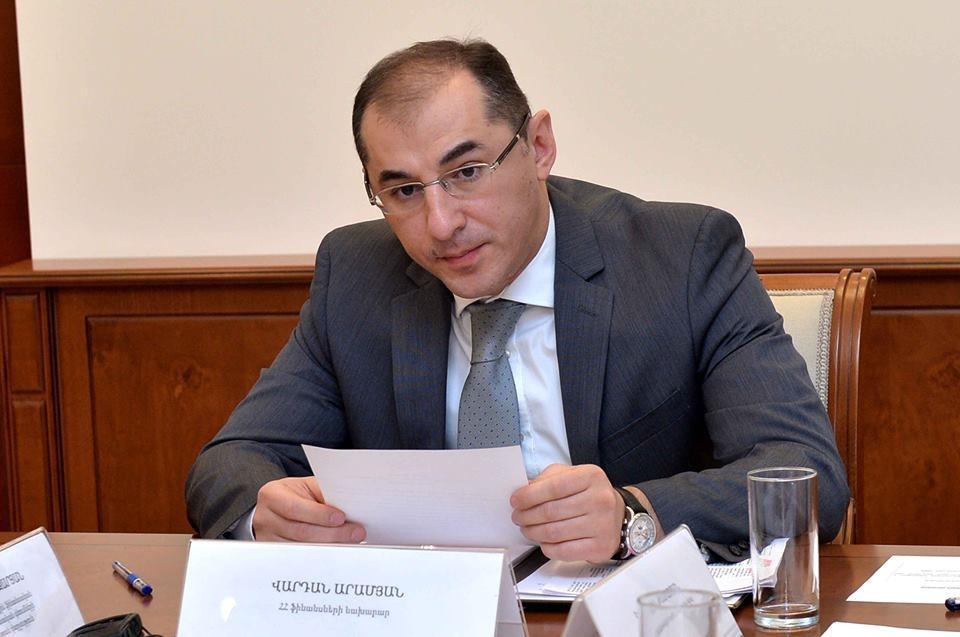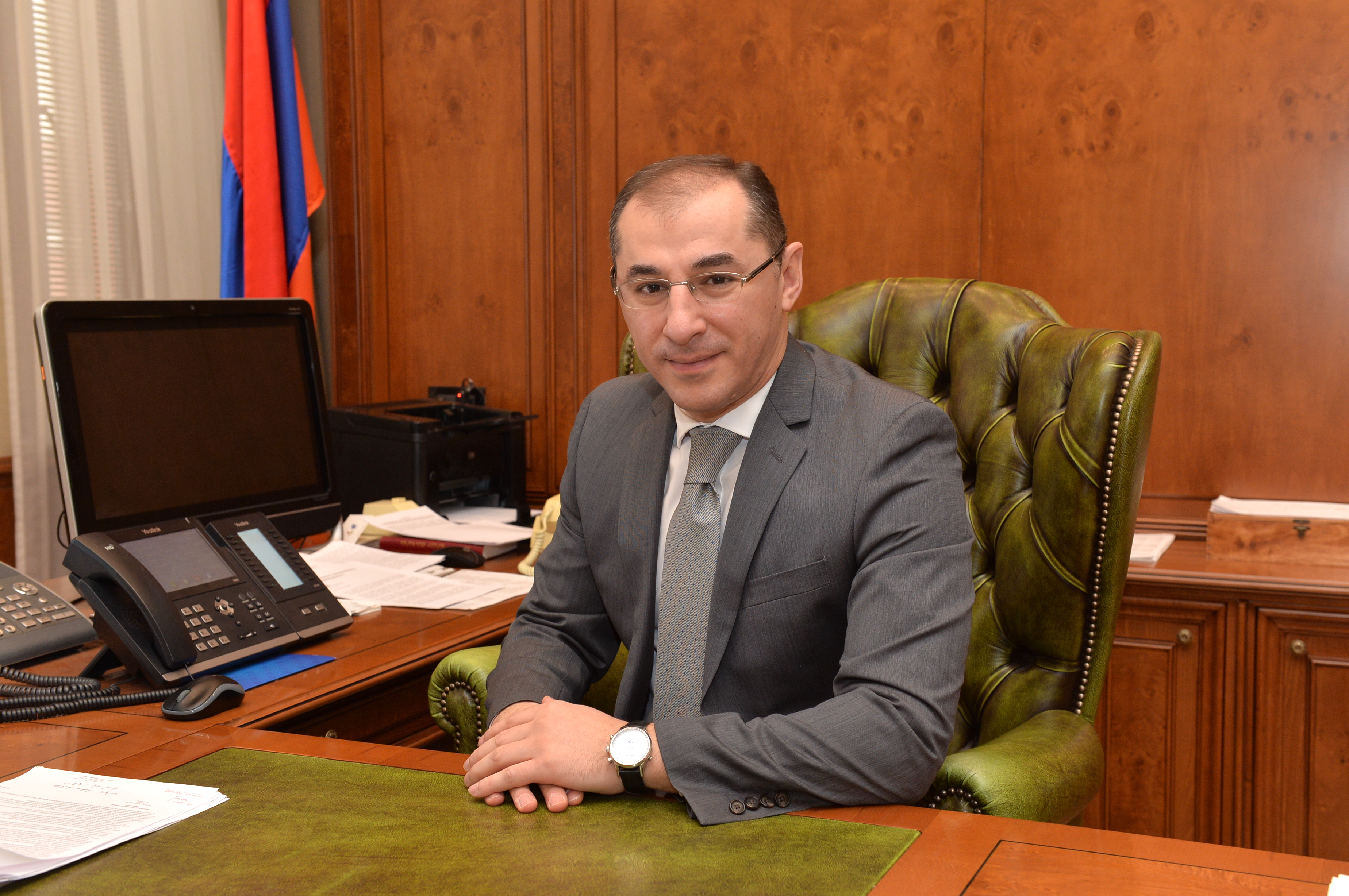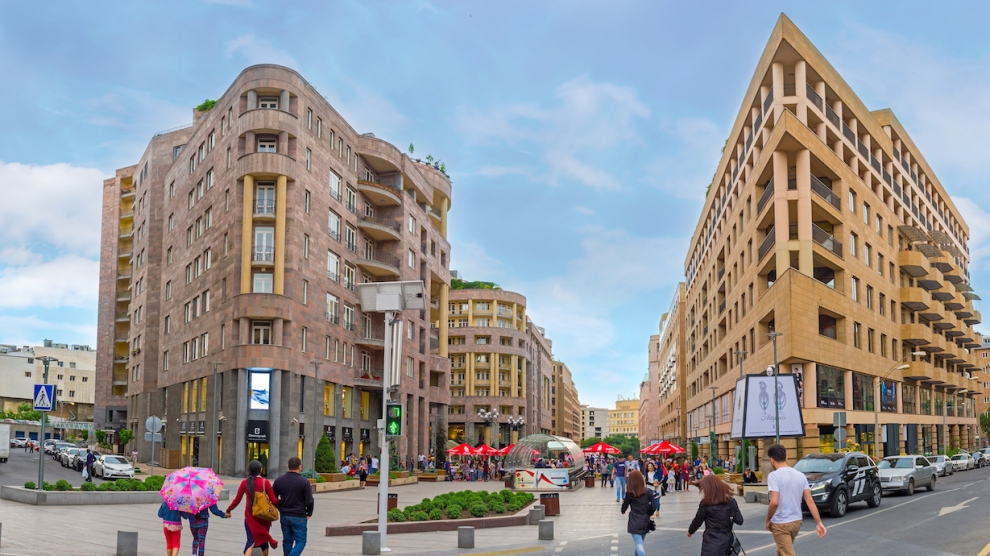In 2017, Armenia’s GDP is expected to grow by 3.2 per cent, says Vardan Aramyan, Armenia’s Minister of Finance. He spoke to Andrew Wrobel about the country’s growing macroeconomic stability and predictability, as well as the reforms that are improving the business climate.
When we look back at the 2013-2015 period, Armenia’s annual GDP growth exceeded three per cent. Now, we see that growth is forecast at 2.9 per cent. What is behind this growth?
That is correct but before I answer your question let me begin by mentioning three major trends that have had an impact on Armenia. In mid-2011, copper prices reached a peak. They got as high as $9,300 per ton of copper, and then gradually began to decline. The price reached its lowest level at the beginning of 2016. This hit Armenia hard because we are an exporter of copper and molybdenum. In parallel with this, during this period major capital flows were turned away from the developing world towards the developed world.
The economic sanctions imposed on Russia in the middle of 2014 have also had a great impact as we have various economic links with Russia. There are two important transmission channels. The first is remittances and the second is export. Around 60 per cent of our processed food goes to Russia.
That means the government had to act. How did you decide to mitigate the risks?
There wasn’t just a challenge and a trade-off. For a long time, there was pressure on the exchange rates firstly because of the negative terms of trade effect that comes from world commodity prices, secondly because of the weaker Russian economy, which caused cutting down remittances and dramatic decline in export proceeds from Russia. If we only take the behaviour of remittances in 2014 and 2015 together, our remittances declined by around 45 per cent. We are anticipating it will decline by a further 11 per cent for 2016. In nominal terms, that’s more than $900 million loss just declining from $2 billion.
Of course, we need to compensate this somehow. There are two major microeconomic tools that can be used to absorb the external shocks and stabilise markets: through fiscal policy or monetary policy, or the right balance of both.

There were two brilliant economists — Calvo and Reinhart, who wrote articles and research papers about the fear of floating, and why dollarised economies are afraid of allowing the exchange rate to float freely, in the developing world. The economists argue that managed exchange rate regime is justified in some instances and anchoring negative expectations in foreign exchange markets that are a result of information asymmetry is the right thing to do. We have done this and now we see that it was a success. We have tightened our monetary policy and tried to anchor the negative expectation towards the unjustified depreciation. From the other hand, to compensate for the contractionary impact of monetary tightening, we have eased fiscal conditions and allowed higher deficit for two consecutive years.
In December 2014, monetary bodies dramatically increased the reserve requirement from 12 per cent to 24 per cent, and the repo rate — from 8.5 per cent to 10.5 per cent by February 2015. This action diminished the appetite of financial market players for borrowing in local currency and buying dollars as local currency became too expensive for playing such a game.
We did understand that each action was going to have its costs, but it’s always the case that you need to sacrifice something to gain something else. We sacrificed low interest rates for local currency borrowings and, as a consequence, growth of credits to economy, but we gained market stability and avoided an overshoot of exchange rate. We did not suffer from turmoil in our forex markets, unlike other countries such as Azerbaijan, Kazakhstan, or Belorussia, Russia. Instead, as I said, we kept our fiscal policy quite flexible.
In turn, fiscal easing cost us an increase in the level of debt, as we were obliged to borrow overseas and finance fiscal deficit. That turned to be slightly higher than was planned for the years 2015 and 2016. That’s why we moved from planned three per cent, in 2015, to around 4.8 per cent of deficit/GDP. For 2016, we feel that we have still not overcome the external negative effect. We had planned for around four per cent, but we ended up at around 5.5 per cent deficit to GDP. This was just a fiscal push that we gave our economy in order to ensure that we had a basis for the future strong recovery, but also for ensuring positive growth rates for 2015 and 2016. As the Americans used to say, there is no such thing as a free lunch. We had costs here as well; I would say the cost was that our debt, in terms of GDP, increased around ten percentage points.
Well, debt is not dangerous if it’s manageable. So how do you see 2017, now?
For the year 2017, we said, “Look, now is time to reverse the situation and have an exit strategy, ” because I needed to have a clear exit plan. Debt sustainability is a must for fiscal policy. Investors are looking at whether we have the required control in our hands, over the debt hikes; and if we were going to do improper things, investors would demand higher yields for their risk. Unpopular and distortive fiscal policy will also penalise our opportunity to get foreign direct investment.
Macroeconomic stability is important for foreign investors. It’s the first precondition for attracting foreign investment. This is because everybody, including the local investors, needs stability. They need to see some predictability and to have a clear understanding about what the government is doing and why, and if we cannot provide them with that we will not be able to convince them to come to our market.
Now, for two consecutive years, I have been obliged to borrow overseas in order to compensate the shortfall of foreign exchange in my market and finance expansionary fiscal policy. Today we have planned strong fiscal consolidation for the year 2017, thus ensuring debt sustainability and macro stability in the medium term. That’s exactly what we are doing for 2017.
There’s one more important thing. We also have a very strong fiscal rule in our legislation, which says that if you exceed 50 per cent of a debt to a GDP ratio, i.e. your public debt in terms of the previous year GDP, then you need to target for a deficit of not more than three per cent over GDP for the next year.
Now circling back to the GDP growth.
Yes, in 2017, we are planning to have 3.2 per cent economic growth, because we think that 2017 should be the year of recovery and stabilisation. First of all, we need to stabilise the environment after the major shocks of the last two years, and then we need to improve that. For 2018 and 19, we are going to target higher economic growth, and we are quite confident that, even five per cent is quite possible for us for the year 2018.
What would be the driver of this growth?
Both the external and internal environment plus our actions. As far as the internal environment is concerned, there are two major dimensions: macro policy and micro-level policy. On the external level, I think this year is already showing some positive signs after Donald Trump’s win in the US We see a strong recovery in the commodity market. China, India and the South American countries are doing better than was planned previously. In 2016, Russia’s economy also stabilised and even the rouble is showing signs of appreciating.
You also mentioned internal factors. What are they?
The first one is our strong commitment to long-running macroeconomic stability. As I said before, because of our prudent fiscal policy and the exit strategy, we are going to make a fiscal consolidation, which is a positive sign for ensuring macro stability. This is the most important precondition for future investment.
The second one is on the micro level. We are currently continuing our policy for export promotion and government support for investment projects in the tradable sectors. We are seeing around a 20% increase in exports after a 4.6 per cent fall in 2015. However, for the year 2017, we are planning for export to show double-digit growth again, because of our actions. Plus, there is a clear reform agenda which will facilitate doing business in Armenia, for example, related to digitalisation of government services. The time to get these services has dramatically decreased; in addition we undertook deep and comprehensive actions for diminishing the administrative burden for businesses such as inspection reforms, administrative guillotine, etc.
We have also created a strategic centre, which is going to act as a think tank and driver of this reform by diagnosing what we have, cleaning up all kinds of unjustified impediments and designing a workable strategy and concrete plans for moving forward.
We’re touching on the business climate now. In the World Bank’s Doing Business 2017, Armenia ranked 38th, higher than year before. So, it is important that you are trying to consecutively improve the business climate. This, plus macroeconomic stability, is something that foreign investors are looking at.
Yes, I agree. As I said, business climate is important from both foreign and local investors and the reforms will result in that.

About foreign investment: according to the World Investment Report, in 2015 Armenia attracted FDI totalling less than 200 million dollars, that is, less than half of the 2014 figure.
That is correct and we think that that figure is too low for our economy. What I find most important, now, in addition to our actions is our communication with investors. It’s important to be honest and open to them in terms of where we stand, what the philosophy is behind our actions and where we’re aiming to be in the next few years. All this has to be measurable and understandable. I do believe that there are many investors who have not been exposed to the opportunities that Armenia offers.
We talked about the internal market, earlier. How is internal consumption doing now?
Well, after two consecutive years of this major shock, of course, there was some harm to consumption. It is showing a little weakness. Why isn’t it going up? The gross national disposable income has also declined. Fortunately, we are now seeing signs of recovery. There are some leading indicators, for instance, performance of retail trade that can hint about the possible behaviour of consumption as consumption statistics are usually publicised much later. If we look at retail trade on a monthly basis, it was in a decline path until October 2016. Then it started to reverse and yearly performance ended up with a positive growth for retail trade — around one per cent growth.
Unemployment seems to be going down too, what is behind that?
Yes, it is declining. Of course, the story behind this is that for the years 2014, ’15, and ’16, our economic growth was mostly driven by those sectors that are labour-intensive sectors: the agricultural and services sectors.
Let me ask you about the Eurasian Economic Union. Is Armenia happy with the benefits of the EEA membership?
Actually, there’s a good saying, “If you want to gain your own benefits, do not blame your counterpart for not having to taking that opportunity.” Instead of blaming others, you need to think about what you need to do in order to gain your own benefits.
Frankly speaking, prior to joining this Eurasian Union, we did our own study and compared what kind of economic effect we would get after having DCFTA (Deep and Comprehensive Free Trade Agreement) with the EU and joining the EEU. The economic short-term effect of an EU DCFTA membership was estimated to be around, hopefully, 1.06 percentage points of our GDP. For a long-term period it was about two percentage points, without the multiplier effect.
What about the benefits of the EEU membership?
Well, we did this study, with support from the World Bank, about joining the ECU. We estimated that we were going to get at least 2.4 percentage points, annually, because of it. Today, people are critical because exports to Russia declined in 2015 but that was because of the depreciation of the Russian exchange rate vis-a-vis the U.S. dollar and appreciation of our currency vis-a-vis Russian rouble in real terms, as well as a dramatic decline in local demand in Russia.
If we only count the impact of gas prices, which we buy from Russia, the 30 per cent export tariff does not apply here because we are a member of the EEU. The nominal effect is around $140 million per year. $140 million is almost 1.4 percentage points of our GDP and I am not talking about the second round effect of energy tariffs. The price of gas translates into energy prices, which have an effect on the cost of supply that is covered by Armenian companies, and for sure, it could harm their competitiveness.
There is also the political aspect of the EEU membership.
Yes, many politicians say that being part of the EU could foster reforms, as the EU is more advanced, but we are working closely with both the EU and the EEU. Actually, the EEU is a custom union at this stage. However, we have a much broader aspect of cooperation with the EU. We are seeing reforms in good governance, reforms in our human rights; judiciary and business environment and we are going to continue that.






Add Comment